
Simulation of borosilicate glasses with non-constant force field molecular dynamics
Abstract
Keywords
Full Text:
PDFReferences
Delaye JM, Ghaleb D. Molecular dynamics simulation of a nuclear waste glass matrix. Materials Science and Engineering B. 1996;37:232-6.
Tilocca A. Sodium migration pathways in multicomponent silicate glasses: Car–Parrinello molecular dynamics simulations. J Chem Phys. 2010;133:014701. doi:10.1063/1.3456712
Verhoef AH, Den Hartog HW. Molecular Dynamics simulations of borate glasses. Rad Effect Defect Solids. 1991;119-121(2):493-8. doi:10.1080/10420159108220770
Varsamis C-PE, Vegiri A, Kamitsos EI. Molecular dynamics investigation of lithium borate glasses: Local structure and ion dynamics. Phys Rev B. 2002;65:104203. doi:10.1103/PhysRevB.65.104203
Cormack AN, Du J, Zeitler TR. Alkali ion migration mechanisms in silicate glasses probed by molecular dynamics simulations. Phys Chem Chem Phys. 2002;4:3193–7. doi:10.1039/b201721k
Smeacetto F, Miranda A, Chrysanthou A, et al. Novel Glass-Ceramic Composition as Sealant for SOFCs. J Am Ceram Soc. 2014;97:3835−42. doi:10.1111/jace.13219
Inoue H, Aoki N, Yasui I. Molecular Dynamics Simulation of the Structure of Borate Glasses. J Am Ceram Soc. 1987; 70(9):622-7. doi:10.1111/j.1151-2916.1987.tb05729.x
Xu Q, Kawamura K, Yokokawa T. Molecular dynamics calculations for boron oxide and sodium borate glasses. J Non-Cryst Solids. 1988;104(2-3):261-72. doi:10.1016/0022-3093(88)90397-3
Vessal B, Amini M, Leslie M, Catlow CRA. Potentials for Molecular Dynamics Simulation of Silicate Glasses. Mol Sim. 1990;5(1-2):1-7. doi:10.1080/08927029008022407
Cormack AN, Cao Yu. Molecular Dynamics Simulation of Silicate Glasses. Mol Eng. 1996;6:183. doi:10.1007/BF00161727
Rossano S, Ramos A, Delaye J-M, Creux S, Filipponi A, Brouder Ch, Calas G. EXAFS and Molecular Dynamics combined study of CaO-FeO-2SiO2 glass. New insight into site significance in silicate glasses. Europhys Lett. 2000;49(5):597–602.
Cormak AN, Du J. Molecular dynamics simulation of soda-lime-silicate glasses. J Non-Cryst Solids. 2001; 293-295:283-9.
Gou F, Greaves GN, Smith W, Winter R. Molecular dynamics simulation of sodium borosilicate glasses. J Non-Cryst Solids. 2001;293(1):539-46. doi:10.1016/S0022-3093(01)00775-X
Sawaguchi N, Yamaguchi K, Sasaki M, Kawamura K. Interatomic Potential Model for Molecular Dynamics Simulation of Lithium Borate Melts/Glasses. J Comp Chem. 2015;14(4):139-46. doi:10.2477/jccj.2015-0017
Scherer C. Molecular dynamics simulations of silicate and borate glasses and melts: Structure, diffusion dynamics and vibrational properties [dissertation]. Mainz (Germany): Fachbereich Physik, Mathematik und Informatik der Johannes Gutenberg-Universitat; 2015. 189 p.
Li X, Song W, Yang K, Anoop Krishnan NM, Wang B, Smedskjaer MM, Mauro JC,
Sant G, Balonis M, Bauchy M. Cooling rate effects in sodium silicate glasses: Bridging the gap between molecular dynamics simulations and experiments. J Chem Phys. 2017; 147:074501. doi:10.1063/1.4998611
Yu Y, Wang B, Wang M, Sant G, Bauchy M. Reactive molecular dynamics simulations of sodium silicate glasses – Toward an improved understanding of the structure. Int J Appl Glass Sci. 2017;8:276-84. doi:10.1111/ijag.12248
Stevensson B, Yu Ya, Ed´en M. Structure-Composition Trends in Multicomponent Borosilicate-Based Glasses Deduced from Molecular Dynamics Simulations with Improved B–O and P–O Force Fields. Phys Chem Chem Phys. 2018;20:8192-209. doi:10.1039/C7CP08593A
Wang M, Anoop Krishnana NM, Wang B, Smedskjaer MM, Mauro JC, Bauchya M. A new transferable interatomic potential for molecular dynamics simulations of borosilicate glasses. J Non-Cryst Solids. 2018;498:294-304. doi:10.1016/j.jnoncrysol.2018.04.063
Car R, Parrinello M. Unified Approach for Molecular Dynamics and Density-Functional Theory. Phys Rev Lett. 1985;55:2471-4. doi:10.1103/PhysRevLett.55.2471
van Duin ACT, Dasgupta S, Lorant F, Goddard WA. ReaxFF: A Reactive Force Field for Hydrocarbons. J Phys Chem A. 2001;105:9396–409. doi:10.1021/jp004368u
Verlet L. Computer "Experiments" on Classical Fluids. I. Thermodynamical Properties of Lennard-Jones Molecules. Phys Rev. 1967;159(1):98-103. doi:10.1103/PhysRev.159.98
Martyna GJ, Tuckerman ME, Tobias DJ, Klein ML. Explicit Reversible Integrators for Extended Systems Dynamics. Mol Phys. 1996;87(5):1117-57. doi:10.1080/00268979600100761
Wu J, Stebbins JF. Cation Field Strength Effects on Boron Coordination in Binary Borate Glasses. J Amer Ceram Soc. 2014; 97(9):2794-801. doi:10.1111/jace.13100
DOI: https://doi.org/10.15826/chimtech.2019.6.1.01
Copyright (c) 2018 Anton Alexandrovich Raskovalov

This work is licensed under a Creative Commons Attribution 4.0 International License.
Chimica Techno Acta, 2014–2025
eISSN 2411-1414
Copyright Notice







